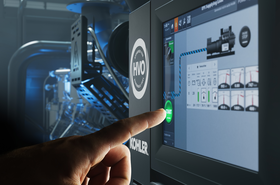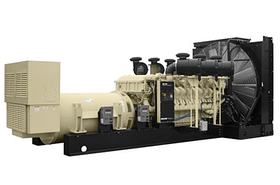A failure of the critical infrastructure in data centers around the world could have massive social, economic and geopolitical effects and, as such, a rock-solid backup power source is far more than a luxury – it’s a lifeline.
The extreme weather that climate change is throwing up, with hurricanes, wildfires and heat waves all contributing to the fragility of often ageing power grids, means there’s no margin for error. Yet, paradoxically, failure to embrace change in this field could simply make the problem worse.
For Kohler, the US manufacturing giant, this presents a headache. By far the most prevalent form of backup power comes from diesel generators and, while they do a solid job, they’re historically dirty, noisy and have a problematic carbon footprint. Or at least they used to. As Jacky Pluchon, Kohler’s vice president of Power Solutions for EMEA explains, the company has placed itself at the forefront of cleaner solutions for those times when the power grid fails.
“It’s something that we want to be part of – to be a sustainable company is[GB1] the future of the company. We’ve allocated a lot of investment into research and development on a diverse range of technologies that will help to position us as a market leader in sustainability. It’s part of the DNA of the company to continuously improve the products and make them better, we all know that we need to live in a more sustainable world, so it’s always been part of our process to improve our products and reduce emissions.”
Although Kohler works alongside companies with a diverse range of requirements, Pluchon recognizes that data centers are a vital part of the global infrastructure, and that even a short amount of downtime can be crippling.
“Today in the data center industry, reliability is key, nobody will accept that their server is down, and today, the best solution remains a generator. They’re easy to deploy, we can install them everywhere in the world with personnel to install and maintain them, and they’re cost efficient. But diesel generators, even though they don’t run much, are not ideal, in terms of sustainability.”
Convincing businesses to completely change their backup infrastructure, which spends most of its time switched off, is a hard sell, and Kohler has been working to find ways, not only to produce new generators that work with cleaner fuels, but also to find solutions that are compatible with existing products.
“We feel that as one of the market leaders we have a responsibility and we’re doing it step by step – there’s no overnight solution. As well as making our products work with alternative fuels, we’ve introduced selective catalytic reduction (SCR) systems, as well as diesel particulate filters (DPF) to reduce the emission of soot particles. It’s a combination of what we want to do, what we can do and what our customers, in this case data centers, are obliged to do: motivating each other to do it together – one can’t do it without the other.”
It’s an ambitious goal, even for a company of the size and history of Kohler. Pluchon explains the first step-by-step increments that take us to today: “The first step was SCR technology, introduced to improve NOx (nitric acid and nitrogen dioxide) emissions in line with standards.
“There’s been a significant improvement in the last 20 years – a 90 percent reduction compared with the early 2000s. NOx emissions are one of the main problems we have to deal with, and we’ve been working with companies, building these kinds of systems and implementing the SCR system on new and existing machines.”
Perhaps unsurprisingly, a big chunk of the process happens less in the workshop and more in the classroom, by educating customers on getting the best out of what they have already got.
“It’s common for companies to be quite conservative and put in bigger generators than they need, so we must optimize these. There is a lot of work to be done to ensure they don’t end up with products they don’t need when building data centers and that means working with companies, suppliers, contractors; we all need to work together to optimize systems.”
Kohler’s responsibility is clear – as much as it would be great to do away with generators altogether, genuinely viable alternatives simply don’t exist yet.
“You don’t go there overnight, it’s a journey. But, step by step, we’re working to propose a compromise between solutions that we can realistically apply and what we hope will be the future, for tomorrow. We know that we need to do better than our best.”
So, for now, generators remain the solution and Kohler’s role is to limit their impact.
“When we are talking about mission critical systems, we can’t afford to have, for example, nuclear power plants at risk of failure. But for a long time people didn’t have that knowledge of the environment. As soon as it became a problem and we saw what needed to be done we started working on this aspect, but the power grid today is not nearly reliable enough. New technology is coming but, at the moment, generators are still the fastest, cheapest way.”
Pluchon goes on to explain that the charge to clean the environment is now moving at a breakneck pace, but it has come about symbiotically.
“I don’t think anything would happen without regulations – but regulations only happened because people were pushing for them. It’s all about people being part of the solution. Today we are all motivating each other to make our environment better. We all realize the consequences of global warming and all have to work as fast as we can without unduly impeding our modern lifestyle.”
Returning to the other important change, the fuel itself. Diesel emissions have seen it move from being more environmentally sustainable, to being vilified in short order, and it has taken biofuels a long time to catch up. Biodiesels – known as B100 – had been around for a long time, but presented as many problems as they solved.
“They created too many problems for the engines” explains Pluchon. “Biofuel with a lot of vegetable by-products were creating pollution that entered the engine, and bacteria that infiltrated the storage tanks.
“Hydrotreated vegetable oil – or HVO – on the other hand, is treated with hydrogen and creates a fuel that doesn’t have all this ‘life’ inside it.”
Now, Kohler is all in on HVO. This diesel free alternative seems to tick all the boxes, providing it is manufactured in an environmentally sustainable way.
“HVO is more of a synthetic fuel, it’s made from waste. The fact that it’s produced the way it is makes it a good fuel in terms of quality. Sometimes it can be better than regular diesel.
“In terms of performance, it works brilliantly and doesn't damage engines so now we’re looking at how we can pivot our entire range of products to support HVO. Now we’re spending a lot of time communicating so people are made aware of the existence of HVO, and hopefully pushing a lot of people to use it.”
But here’s the game changer.
“It can be blended with diesel, which is great because you may have hundreds of thousands of liters of diesel on-site already, so you don’t have to empty your tanks and start again – you can just refill the tank with HVO next time and carry on and then, say, if tomorrow for some reason there’s no HVO available, you can put regular diesel back in the tank and it’ll continue to work. And there’s no maintenance and testing needed above that of a diesel engine.”
But despite this major leap forward, Jacky Pluchon has already explained that this is a step-by-step process – and Kohler isn’t resting on its laurels.
“Most data centers are rarely running their generators, purely because power outages in data centers are rare. So the next step for us is to be able to reduce testing to one hour a year instead of one hour a month as it is today. You’ve already dropped your carbon footprint by 90 percent by using HVO, then if you divide that by twelve, you’re reducing that footprint even further. HVO is still a little more expensive than diesel, but if we can cut annual testing to once a year, we can save hundreds and thousands of liters and offset that price discrepancy.”
So running cleaner fuels, less often is where we are today. But what about tomorrow? Are other fuel sources on the horizon?
“Hydrogen will be the big green fuel one day – but it’s too soon – alternatives need to exist, but they need to be compatible, the supply chain has to be organized, and then you have to have the right people to install and maintain those products. How many engineers can you find who will be able to maintain a hydrogen fuel cell, compared to an engine that has existed for 40-50 years?”
What about batteries? It’s certainly part of Kohler’s approach, but perhaps, for data centers, not ideal.
Pluchon explains: “Kohler is developing solutions involving batteries, but they take up a huge amount of space – 200 megawatts of battery on site would be absolutely massive, and may only keep a center online for a few hours at best, so it isn’t a full solution today. Eventually they will come down in size and grow in capacity, and will become part of the mix in the future, but not the whole solution.”
At the heart of Kohler’s drive for cleaner engines is educating the customer, and building the trust that their products, running solutions like HVO, will serve them just as well, if not better.
“Trust is certainly something that we need with new solutions, driven by transparency. When you sell an engine today, customers want to know that they have the right resources to control and maintain those products on-site, once they are operating.
“Tomorrow, as we look to roll these solutions out to more remote places it will be even more of a challenge because it takes time to train people and then you need to keep them up to speed so they can be deployed anywhere.”
So, this is the Kohler vision of environmentally sustainability, with a heavy dash of realism. But the most important thing that Jacky Pluchon has to say, he saves for last. Because although Kohler wants to lead the charge into a cleaner world – neither it, nor any other organization can do it alone.
“We have the same goals, to see a more sustainable world. We all succeed together – it's not about one company or one business, it's a collaborative cooperation between customers, manufacturers, contractors that are building data centers.
“It's how we can create the right design and the right product from the very beginning and, by sharing knowledge it will go faster, we all know we don’t have the time we would like in front of us to do it, so by working together we’ll thrive sooner.”
To find out more about sustainable backup solutions, please visit the Kohler website here.
More from Kohler
-

Sponsored Kohler HVO Fuel Capabilities provide data center customers with a pathway to zero carbon
Hydrotreated Vegetable Oil (HVO) fuel delivers significant carbon savings
-

Kohler approves all its gensets to run on vegetable oil
Hydrotreated vegetable oil can replace diesel for backup power
-

Sponsored How to give your generator a sustainability advantage
With backup power and sustainability essential to any data center, are diesel generators finally turning over a new (greener) leaf?

